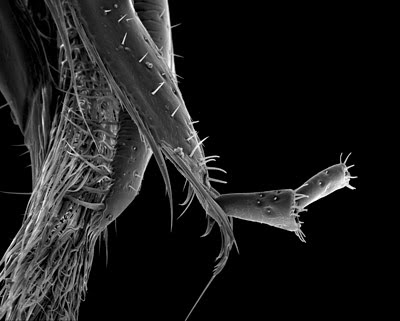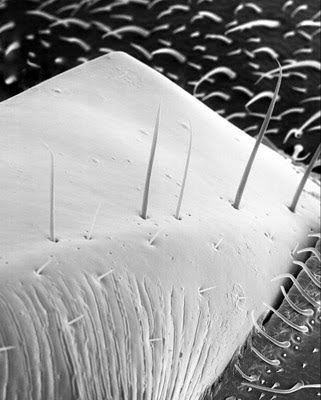Rose-Lynn Fisher
Next spring when nature is in full bloom, you will undoubtedly notice who is also benefiting from those floral displays, and Rose-Lynn Fisher’s amazing images will come to mind. Rose-Lynn has been fascinated with bees for the past seventeen years, and now has a book, BEE, published by Princeton Architectural Press, and an exhibit at the Farmani Gallery in Brooklyn with the same title. The exhibition opens tonight, June 3rd and will run through the 26th. Rose-Lynn will be at the gallery on June 19th from 1-5pm for an artist’s talk.
Rose-Lynn photographs the honeybee with a scanning electron microscope, that allows her the ability to examine the bee’s anatomy as art in ways that can’t be viewed by the naked eye.
The first time I looked at a bee’s eye magnified I was amazed to see a field of hexagons, just like honeycomb. I wondered, is this a coincidence or a clue? Is it simply that hexagons are ubiquitous in nature, or is there a deeper correspondence between the structure of the bee’s vision and the structure she builds – in other words, similar frequencies being expressed in similar form? This got me pondering on the connection between vision and action at a more abstract, metaphoric level. Is there a parallel kind of encoding relevant to humanity? At a refined level of our own nature, does our deeper capacity to see and to do correspond with an intrinsic structuring?
As though revealing a secret, the scanning electron microscope presents a realm of structure, design and pattern at a level of intricacy we are oblivious to in our daily experience. In this bizarre frontier our sense of scale is confused, and connections between the micro and macro world become clearer and more tangible. In the myriad forms that constitute one little bee at higher and higher magnifications is a hint of the unending complexity of nature, the worlds within worlds comprising our reality. And then the realization – we are part of this too! It’s enough to rouse a mind to challenge itself; to inspire our best blend of observation and imagination, and apply it to making a better world.
The ultimate pollinator, an alchemist transmuting nectar into honey, architect, spatial genius and winged apothecary, the honeybee has been revered and utilized by civilizations throughout time. Our sustenance is dependant on bee pollination for one third of what we eat. The plight of bees due to colony collapse disorder, pesticides, habitat loss, mites, and other issues is prompting us to wake up to their needs, their necessity to us, and to take responsibility for restoring and protecting their health.
Honeybees live in a peaceful society whose industries benefit life. How can we emulate their example of harmlessness and beauty? For me, the honeybee symbolizes and embodies a congruency of form and function, vision and action, spirit and matter, all being of the same essence. I offer these photographs in celebration, respect and gratitude for all that they do and are.
Posts on Lenscratch may not be reproduced without the permission of the Lenscratch staff and the photographer.
Recommended
-
Smith Galtney in Conversation with Douglas BreaultDecember 3rd, 2024
-
Michael Rababy: CASINOLAND: Tired of WinningNovember 29th, 2024
-
Kari Varner: Blueprints for Slaughter and GroundworkNovember 14th, 2024
-
Jason Lindsey: FRAYED DREAMS UNDER STARS AND STRIPESNovember 12th, 2024
-
New England Portfolio Review: Ann Hermes: Local NewsroomsOctober 24th, 2024






































































